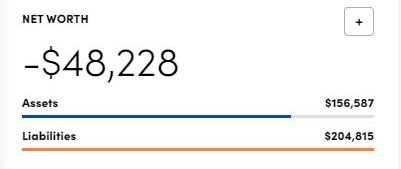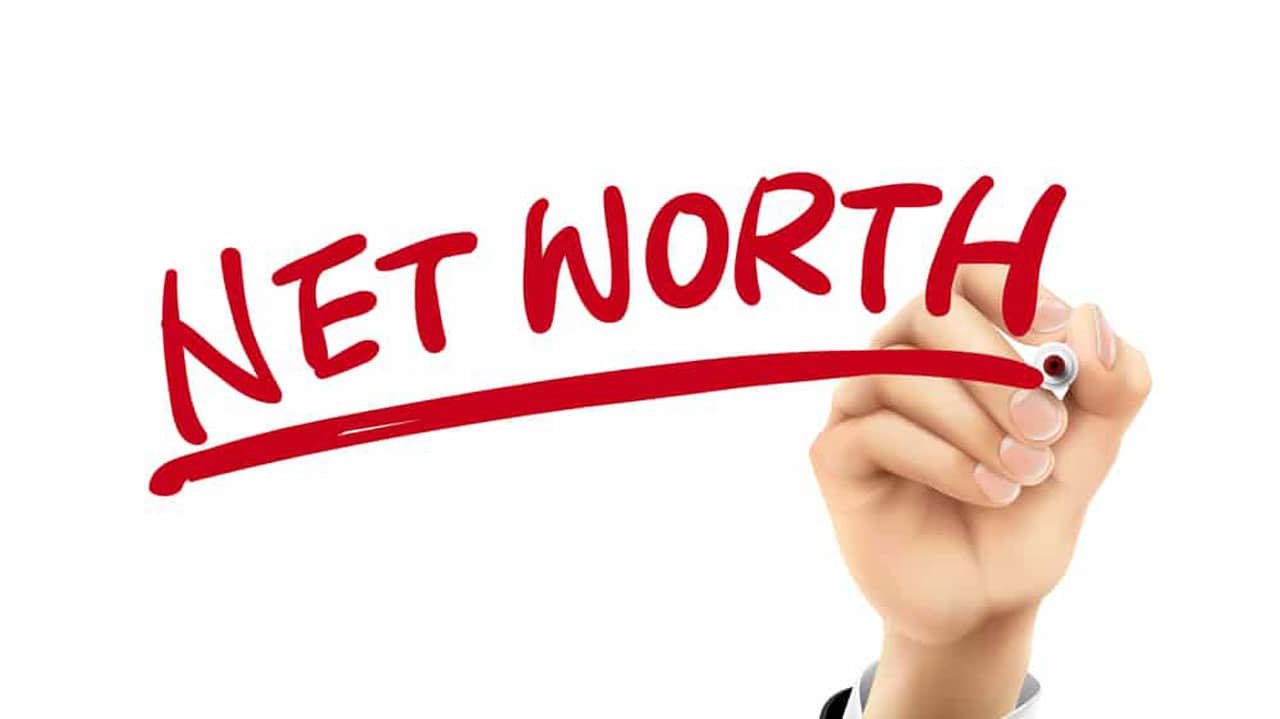I will make personal financial updates a regular part of TheMoneySloth.com and this post will summarize the starting point for tracking my progress toward financial freedom. As you may have seen in my first post, Introducing The Money Sloth!, I am starting this journey with a negative net worth of -$48,228. You’ll be able to track the change in my net worth on the right side of the blog too. As you will see in the numbers below, my negative net worth is the result of a substantial amount of student loan debt from undergraduate and graduate school.
Student Loan Debt Crisis
The student loan debt crisis is only growing more dire each and every year. Student loan debt in America is now about $1.56 trillion and growing rapidly. This debt is spread across 45 million borrowers and about 3 million of those borrowers owe more than $100,000. While hindsight is 20/20, there are many decisions that I wish I could go back in time and change but, we don’t live in a world of DeLorean time machines so I have to forge ahead. I make no excuses for the student debt I have accumulated. It is the result of several transfers both at the undergraduate and graduate level as life circumstances changed, as well as the belief that a graduate education would benefit my career. I have many more posts planned to discuss student loans, so please subscribe to The Money Sloth in the upper right corner to get e-mail updates.
Net Worth
The following screenshots are from my Personal Capital account. I highly recommend that you sign up for this free service as it makes tracking your finances a breeze! If you sign up through my special Personal Capital referral link, you’ll also get a $20 bonus once you link your first investment account to Personal Capital (again, it’s 100% free). Once you’ve signed up for Personal Capital, all you have to do is link your bank accounts, credit cards, and loans and you will then get a series of data points that will make it easy to track your spending, saving, and setting your money goals.
 On the top-left of your Personal Capital account will be your current Net Worth. This figure takes your total assets and subtracts your total liabilities, essentially informing you what you would have leftover if you cashed in all your assets and used it to pay off all your debts. As you can see, my net worth is negative. A negative net worth means that even if I cash in all of my assets, it still wouldn’t be enough to pay off my debts. In many situations, a negative net worth can be resolved through bankruptcy, however student loans are not typically dischargeable in bankruptcy so it is not an option for someone with substantial student loan debt like myself.
On the top-left of your Personal Capital account will be your current Net Worth. This figure takes your total assets and subtracts your total liabilities, essentially informing you what you would have leftover if you cashed in all your assets and used it to pay off all your debts. As you can see, my net worth is negative. A negative net worth means that even if I cash in all of my assets, it still wouldn’t be enough to pay off my debts. In many situations, a negative net worth can be resolved through bankruptcy, however student loans are not typically dischargeable in bankruptcy so it is not an option for someone with substantial student loan debt like myself.
The median net worth in the United States is currently $97,300. That means that half of American households are worth more and have are worth less. It is estimated that 20% of American households have a zero or negative net worth and, based on this analysis, I’m included in that group.
The breakdown of my assets and liabilities as of July 1st are as follows:
|
Assets |
Amount |
| Checking/Savings/CD |
$41,998 |
| Retirement Accounts |
93,882 |
| Taxable Investments |
15,707 |
| Misc. (Gold/Silver/Cash/Collectibles) |
5,000 |
|
Total Assets |
156,587 |
|
Liabilities |
Amount |
| Credit Cards |
$6,329 |
| Student Loans |
198,486 |
| Total Liabilities |
204,815 |
Putting these numbers in front of yourself for the first time is a difficult thing to do. I’m reminded of the old adage, “out of sight, out of mind.” Many people choose to simply ignore the situation and never sit down to figure out what their assets and liabilities are. The first step is often the hardest and once you’ve taken the time to lay out your financial situation in front of yourself, you can start to make a plan based on that information. What you’ll see from my own situation is that I’m definitely not perfect, but am determined to make a change and help others do the same. Let’s have a look at what’s going on in my asset and liability tables:
Assets
The first thing I notice here (and Personal Capital pointed out) is I have way too much in my checking and savings accounts not earning much of a return. I’ve seen the yield on my high-interest savings account drop to below 1% in the past few weeks too. I’ll admit, this cash balance is high due to pulling a lot of investments out of the market as a result of the current economic environment amidst the Covid-19 pandemic. Interestingly, the performance of the stock market has been completely detached from the economic reality, but that’s a discussion for another post.
The balance in my retirement accounts is the result of trying to contribute as much as possible to my IRA, Roth IRA, and employer-sponsored retirement account for the past five or six years. In years I had lower earnings, I contributed to the Roth IRA and now that my income is growing, I have been shifting to contributing more pre-tax dollars for retirement savings. I have not yet contributed to my Roth account for the 2019 tax year as the contribution deadline has been extended to July 15th. In order to draw down my checking/savings balance, I plan to contribute the maximum $6,000 to my Roth IRA for 2019 when a CD matures this week. This will transfer some excess cash to a tax-advantaged account that will allow it to grow and be withdrawn tax-free in retirement.
Emergency Fund
 A good rule of thumb for an emergency fund is 6 months of expenses. I try to keep my expenses under $3,000/mo, so that would imply a need for an $18,000 emergency fund. Obviously this is an area I need to tackle first as extra cash is just wasting away to the ravages of inflation. After the Roth IRA contribution, I will have 12 months of living expenses in savings. The likely plan for this extra $18,000 is to max out my employer-sponsored retirement account for the year in order to lower my taxes. The maximum 401k elective deferral limit for 2020 is $19,500, plus an extra $6,500 for those age 50 or older – of which I am not. I am currently in the 30% marginal bracket for federal and state income taxes and I expect my tax rate to be lower in retirement, so it makes sense to max out this account, if possible.
A good rule of thumb for an emergency fund is 6 months of expenses. I try to keep my expenses under $3,000/mo, so that would imply a need for an $18,000 emergency fund. Obviously this is an area I need to tackle first as extra cash is just wasting away to the ravages of inflation. After the Roth IRA contribution, I will have 12 months of living expenses in savings. The likely plan for this extra $18,000 is to max out my employer-sponsored retirement account for the year in order to lower my taxes. The maximum 401k elective deferral limit for 2020 is $19,500, plus an extra $6,500 for those age 50 or older – of which I am not. I am currently in the 30% marginal bracket for federal and state income taxes and I expect my tax rate to be lower in retirement, so it makes sense to max out this account, if possible.
Some common assets that might seem to be missing here include a car, house, and personal possessions. Living in Washington, DC, I have purposely located myself in a neighborhood with easy access to transportation options in order to get to work or anywhere else I may need to go. In addition, the cost to park a car at my apartment building is $250/mo. and I’m just not interested in paying that much. I completed a cost/benefit analysis of whether or not to own a car after moving to DC and the bottom line is that it is much cheaper to just utilize Uber, Lyft, bikes, and scooters than to own a car here. Another common asset that is missing is personal possessions and I chose not to include those simply because I don’t own a whole lot of “stuff.” In addition, personal belongings like clothing, furniture, and books are simply not worth anywhere close to what you pay for them since they are now used. For this reason, I’m excluding any estimates of personal belongings from my net worth calculation. As for a house, well in DC I get a much better deal as a renter than an owner right now.
Liabilities
The $6,329 in credit card balances is either at 0% or part of a card balance that is paid off monthly. One thing that I am fanatical about is not paying interest on my credit cards. This balance will ultimately get paid down before the 0% APR promotion expires in 2021. Did you know that some of the most popular credit cards have interest rates as high as 25%? Even the average interest rate can be over 15% and will make carrying balances from month-to-month an extremely expensive proposition.
The elephant in the room is that $198,486 in student loan debt. The vast majority of this balance is in the form of federal stafford and grad plus loans, with about $15,000 of it in private loans recently refinanced at a 5% fixed rate through Credible (currently offering up to a $200 bonus for refinancing your loan through them). The federal loans are currently in a 0% interest rate status as part of the emergency pandemic legislation that paused all interest and payments on student loans through September 2020. Otherwise, these loans average about 6% interest and my payments are computed using the Revised Pay As You Earn (REPAYE) program. The REPAYE plan requires that I pay 10% of my income, that exceeds the national poverty level, each month toward these loans.
I do not currently hold any other liabilities like a mortgage, personal loan, or car loan and based on my current circumstances living in Washington, DC, I do not anticipate getting a mortgage or car loan anytime in the future. I have poked around at some real estate listings in my neighborhood and 1 bedroom condos are selling for $450-600k, and renting comes out much cheaper for me even after considering potential growth in real estate prices.
This completes the breakdown of my current assets and liabilities. The second installment of this post will cover my starting point for income and expenses and setting a budget for the remainder of the year. Don’t forget to subscribe to The Money Sloth so you get updates on new content!






3 Comments